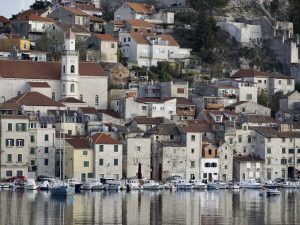When you look at a map, you might see that Croatia is shaped kind of like a boomerang with its capital of Zagreb in the middle surrounded by the region considered to be “Croatia proper”. At the extremity of the northern “wing” is the region of Slavonia. At the extremity of the southern wing is the region of Dalmatia and its many island stretching along the Adriatic Sea. It’s not a perfect boomerang, though, mainly because a fourth region sticks out like knot of wood on the front edge of the boomerang. This region, called Istria, is geographically a peninsula and culturally has its own unique history and identity.
After our brief visit to Zagreb, we traveled by bus to Pula, which is the largest city in Istria and seventh largest city in Croatia with 52,000 permanent inhabitants. Only three cities in Croatia have a population greater than 100,000; those are Zagreb (~770,000), Split (~160,000), and Rijeka (~110,000). Pula is the capital of the Istrian region and sits almost at the very southern tip of the triangular peninsula.
Croatia is about 21,000 square miles (56,594 sq km), making it about the size of West Virginia and one-third the size of Wisconsin. Because of the boomerang shape and the mountains, getting around Croatia is a little challenging but their highways are pretty good with some impressive tunnels. Croatia also makes heavy use of ferries to connect the mainland to its numerous islands. Of the 700+ islands in the Adriatic (plus an additional 300 uninhabitable “islets”), about 48 islands have permanent inhabitants. In total, the islands constitute 5% of Croatia’s total area and only 2% of the total population (and dropping as young people are increasingly leaving for better economic opportunities in the cities and old people continue the annoying habit of dying off).
Istria itself is NOT an island but the peninsula is sufficiently separated from the rest of Croatia by mountains and forest that it kind of feels like an island. Only one major road connects Istria to the rest of Croatia at a corner of the Adriatic by the city of Rijeka. From that point, the Istrian peninsula shares only 12 miles of a north-south border with mainland Croatia before reaching the neighboring country of Slovenia (where the red and green touch on the image below). Istria itself has an area of just over 1,000 square miles (2,800 sq km) making it about the size of Rhode Island or half the size of Door County in Wisconsin. Its triangular shape is not long and skinny so getting from on side to the other is pretty easy except for the mountainous area in the very north.


Overview of Istria (source: Wikipedia) and our bus route from Zagreb to Pula which sits near the southern tip of the Istrian peninsula. We will not be visiting the Slavonia region bu I looked at why Baranya is broken out as a distinct entity and it leads down a deep historical rabbit hole which in ways reflects the complex history of this entire region. Sometimes it seems like a Venn diagram is more appropriate than a map to understand the Balkans.
The 160 mile (270 km) bus ride took 3.5 hours and included a mandatory 10-minute rest break at a rest area. We arrived in Pula and enjoyed yet another walk in the rain from the bus station to our apartment, which thankfully (and by dumb luck) was only half a mile away. Our Air BnB host was a super friendly middle aged lady named Dubrovka who lived in the apartment above our little studio. She is an English teacher and enjoys traveling so we had a great conversation with her and got some good advice on what to see in Pula and in Istria. She is planning her own vacation to Morocco in January which resonated with us because that was our second choice after Croatia for where to spend our month outside of the EU. Dubrovka recommended a wood-fired barbeque restaurant a few blocks away called Kod Kadre which specialized in Cevapcici (kind of a cross between sausage and meatballs). Can’t say it was the healthiest meal I’ve eaten but, wow, was it tasty.
We also made a grocery run to the nearby Konzum (the Food Lion of Croatia) and on the way we came across another memorial for the Croatian Remembrance Day (18 NOV) we had learned about the day before in Zagreb. Despite the wet and windy weather, the candles were still burning ; their design suggest Croatians must be accustomed to rain at this time of year.
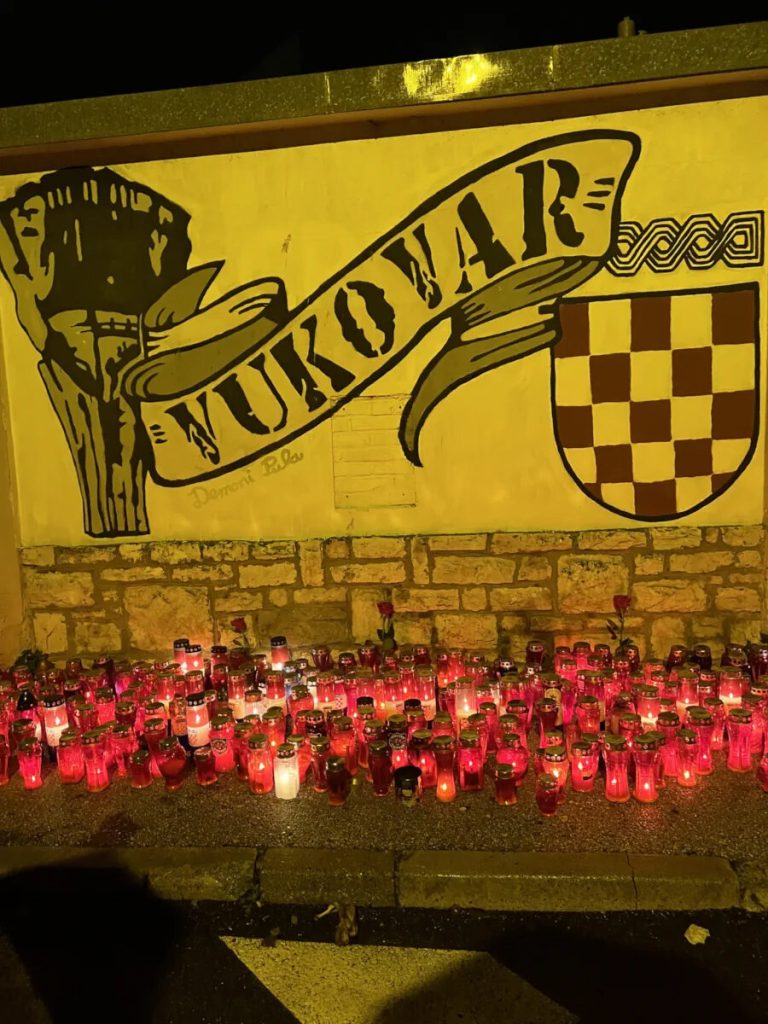
A Much Nicer Room
After my comments about our rather depressing apartment in Zagreb, I wanted to set the record straight that quality lodging at a low price can indeed be found in Crotia. Maybe just not in central Zagreb. Our second floor studio in Pula had a bedroom, a kitchen, a small bathroom, and a two-chair balcony. It was nicely decorated with batiks and pottery Dubrovka had done herself. The thermostat worked great and it was nicely lit; pretty much 180 out from our experience in Zagreb. Best of all, when I turned on the TV, one of my favorite childhood shows was (dubbed in German). Long live the 80’s (and the late 70’s). Thanks to the off season, our apartment was only $36 per night (with taxes and cleaning fees). We liked Pula already.





Best Roman Ruins Outside of Italy
Croatia is a country of superlatives, partly by self-promotion. Over and over, we read about the oldest, the biggest, the smallest, the shortest, the longest, etc. One of Croatia’s claims is the best preserved Roman amphitheater and this is not not a case of hyperbole; just ask Wikipedia. Our apartment was only two blocks away and uphill from the amphitheater so it was a short walk from “zero to pow” when we saw the amphitheater in the bright sun. It was the Sunday before Thanksgiving and we weren’t sure whether tourist attractions would be closed on a weekend in the off season. To our pleasant surprise, it was open for business. Two tickets, please.
Although this is the most intact Roman amphitheater in the world, it nonetheless suffered a fate similar to other Roman structures and a substantial portion was de-constructed as a source of building material for other structures, including the foundation of the bell tower at the Pula cathedral. The Venetians controlled Istria for over 200 years and seemed to be particularly adept at pilfering structures to obtain building material for the city of Venice. Pula had a church called Santa Maria Formosa built in the 7th and 8th centuries which was demolished to provide construction material for the Marciana Library and Saint Mark’s Basilica in Venice. In the late 1500s, the Venetian Senate even proposed dismantling the entire Pula amphitheater and re-constructing it in Venice (kind of like London Bridge ending up in Arizona). Thankfully, this proposal did not pass and eventually the bishop forbade further removal of material. Restoration efforts in the 1800s and since have stabilized the amphitheater as an exceptional remnant of a the ancient world.
One portion of the amphitheater has stone “bleachers” and with wooden safety railings enabling the use of the amphitheater for concerts and other events. It can seat about 5,000 people and has been used for concerts in recent years which include Elton John, Foo Fighters, Sting, Arctic Monkeys, David Gilmour, and many others. To be clear, in Roman times, this was called an “arena” which is Latin for sand and was used for gladiatorial games. These walls have seen the full spectrum of human creativity for entertainment over the centuries, from the sinister to the sublime.






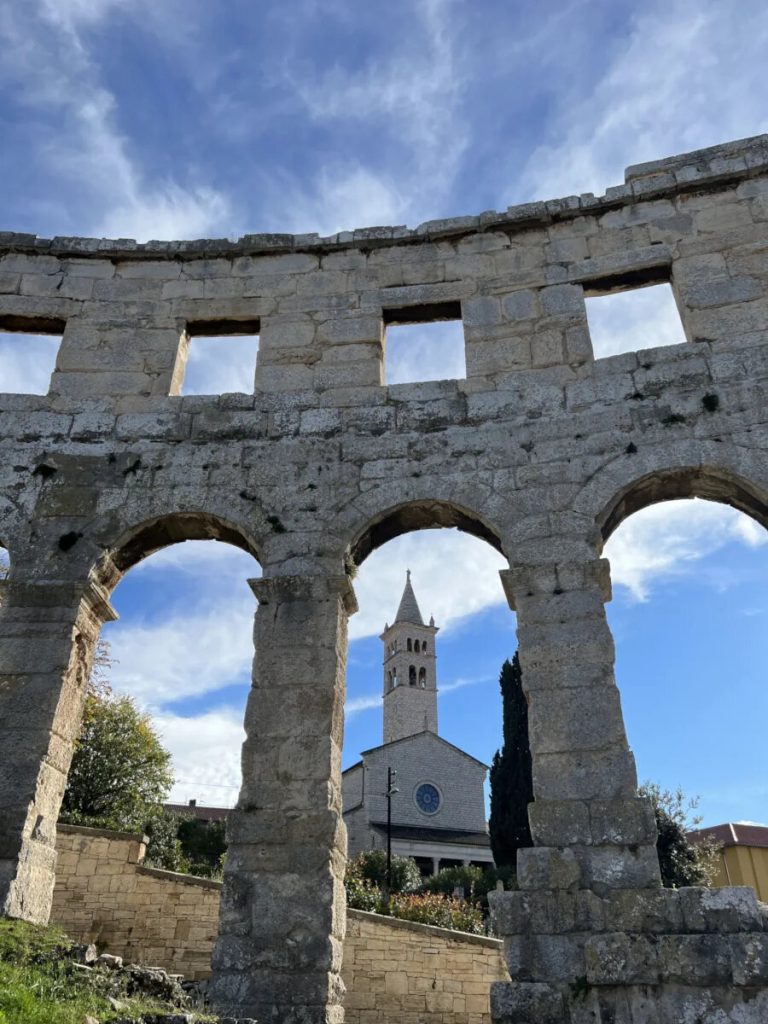

The amphitheater has a museum underneath in the passages where gladiators, animals, and arena operators would move about to put on the big gladiatorial shows. The museum is partly about the amphitheater itself but also covers the broader history of Roman rule in Istria and the importance of olive oil and wine production as the main purpose of Roman administration and the economic and political power that stemmed from brining “Big Agriculture” to this region.
The first photo below shows the major cities in northern Italy and the Adriatic along with lines of communication. The city of Aquileia near Venice was the major hub of Roman power (it had 100,000 inhabitants at its peak under the Romans and has since shrunk to barely 3,000 mainly due to its river changing course among other factors). The second photo describes the amphitheater including its dates of construction from 31 B.C. to 96 A.D. and its major constituent parts (spectator area, the arena itself, and the subterranean passages and chambers). Interestingly, the subterranean area was carved out of solid rock. The third photo is a map of Istria identifying Roman cities, towns, villages, agricultural estates, fortifications, potteries, ports, and roads. Istria was an important agricultural area in the early days of the empire and a staging base for expeditions eastward as the empire expanded. In the fourth photo, we made the obligatory exit through the gift shop and experienced a wave of nostalgia when we saw the wooden swords for sale. This reminded us of our two years in Italy when our boys were 5 and 7 and everywhere we went we’d end up buying wooden swords to keep them interested and happy (it worked great).
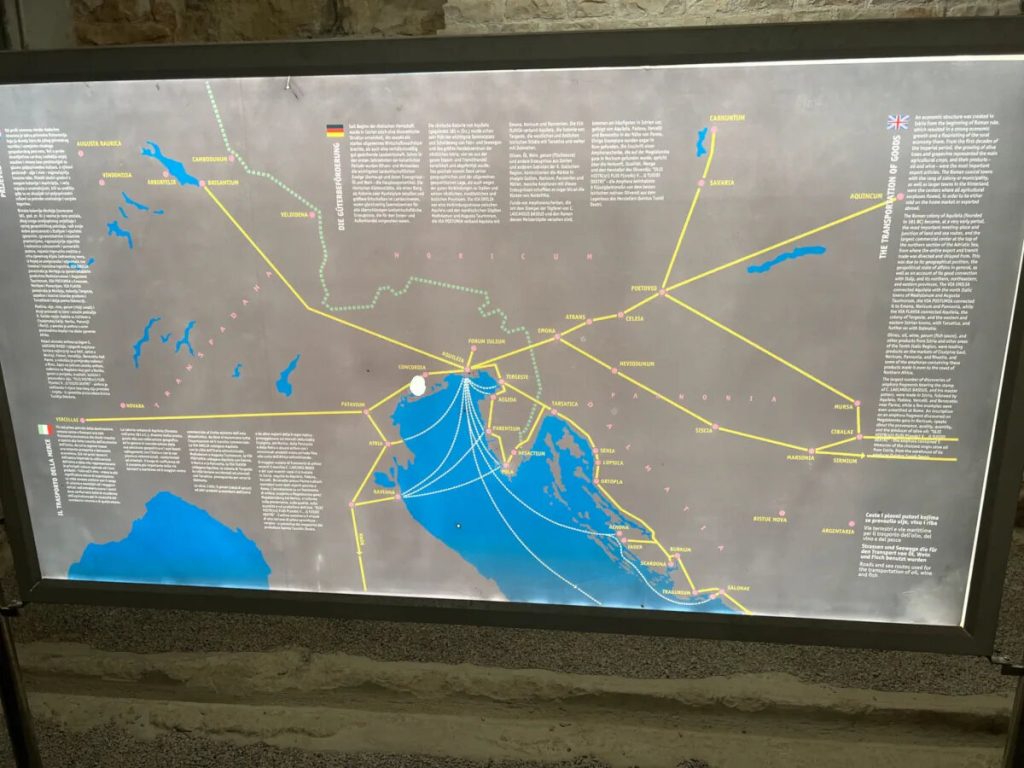



Croatians love tunnels
After the amphitheater, we found lunch on another recommendation from Dubrovka. Then we visited Pula’s underground tunnels called the Zerostrasse, which were built during WWI as shelter for the city’s residents. The tunnels were dug from four directions which all met at a central point. Today, the tunnels are a museum and also provide an elevator to the hilltop fortress overlooking the city.


This fortress on top of the hill also houses a museum as well as gallery for art exhibitions. The fort was built to complement the defense of the Austro-Hungarian Navy and feels a lot like the coastal defense forts built in the U.S. in the 1800’s (Fort Adams, Fort Monroe, Fort McHenry, Fort Sumter, etc). This fort is one of several in a system protecting the city of Pula and, more importantly, its harbor.
Submarines and How to solve a problem like Maria
Growing up in the dark ages before on-demand TV, our family watched the Sound of Music almost religiously when it made its annual appearance on network TV as a special event; same goes for Willy Wonka and the Chocolate Factory, Chitty Chitty Bang Bang, and the Wizard of Oz. I saw the Sound of Music enough times to eventually wonder where the heck Austria, a landlocked nation, had ships needing a Navy captain. In 1938, the answer was “they didn’t”, but Captain von Trapp was a highly decorated submarine officer for the Austro-Hungarian Imperial Navy during WWI and that Navy was based predominantly in Pula when Istria was part of the Austro-Hungarian empire. Of course, the movie is set at the time of Nazi Germany’s Anschluss (annexation of Austria) and they wanted Captain von Trapp to serve in their U-boats; his refusal to do so on ideological grounds is part of what drives the storyline of the movie. But where exactly did Austria have a submarine force during WWI? We learned in the fortress museum that Pula was the major naval base of the Austro-Hungarian Navy for over 100 years. Not only was its fleet homeported in Pula, but its strategic importance made it a key target for the enemies of Austria-Hungary.
One of the exhibits in the fortress museum depicts an episode during WWI in which the French diesel submarine Curie (Q 87) attempted to infiltrate the harbor to sink Austro-Hungarian ships, but got entangled in the anti-submarine nets. The submarine was forced to surface, was fired upon, and sank with three deaths and the rest of the crew taken prisoner. The Austro-Hungarian Navy subsequently salvaged the boat and re-commissioned it as U-14…under the command of CAPT Georg von Trapp. In a six-month period in 1917, von Trapp sank 11 Allied ships with that former French sub. Despite von Trapp’s successes, he still ended up on the losing side of the war. The Austro-Hungarian Empire was one of several empires to become a casualty of WWI. In the treaties that ended the war, Istria (and Pula) passed to Italy and remained under Italian rule for 25 years between the two world wars. Overnight, Austria lost its access to the sea and thus its role as a global sea power.
To complete the story, in 1926, Captain von Trapp was retired from the navy and from submarines. He was also independently wealthy from the inheritance of his first wife who was an Austrian-English aristocrat and died at the age of 31 in 1922 after having already given birth to the seven children who became the famous singers. Two years later, Captain von Trapp hired a 22-year old tutor (named Maria) for his daughter (also named Maria). Maria the tutor indeed came from a nearby abbey and indeed fell in love with and married Captain von Trapp, who was 46 at this point. The movie hints at Maria the tutor’s youthfulness, but kind of glosses over the magnitude of the age gap. von Trapp subsequently lost his fortune in 1935 when the Austrian banks failed and then turned to show business with his kids to help make ends meet.
The Sound of Music wasn’t the first or last Hollywood production to take a lot of liberties with the real story, to include the historical misplacement of their marriage by nearly 15 years. During WWII, the family emigrated to the U.S. and lived near Stowe, Vermont. Captain von Trapp died of lung cancer just a few years later in 1947 at the age of 67; submariners of that era suffered from a variety of pulmonary problems as a consequence of their service. His (second) wife Maria lived another 40 years and died in 1987.
Bit of a rabbit hole but that’s the connection between Pula, a submarine named after Marie (and Pierre) Curie, and the Sound of Music.


Lead Zeppelins
The museum also had an interesting exhibit about an Italian airship (zeppelin) that was shot down by the Autro-Hungarians during the airship’s return from a bombing run on Fiume (modern day Rijeka). Torpedo boats from Pula rescued the surviving air crew and took them prisoner.
Later in the week we visited a national park on the Kamenjak peninsula just south of Pula. The national park website had this interesting anecdote about WWI which I thought was humorously written: “A lesser-known but very interesting fact is that during World War One gigantic searchlights were deployed in the area of Upper Kamenjak. The searchlights were used as a decoy for the naval port of Pula, which was the main target of the Italian Air Force. Attracted by the bright lights, Italian pilots would then think they were bombing Pula. You can only imagine what the locals of Premantura thought about the people of Pula at that time.”
All of this is a long way of saying that I thoroughly enjoyed reading about these events which, for me as an American naval officer, were both obscure and highly interesting.
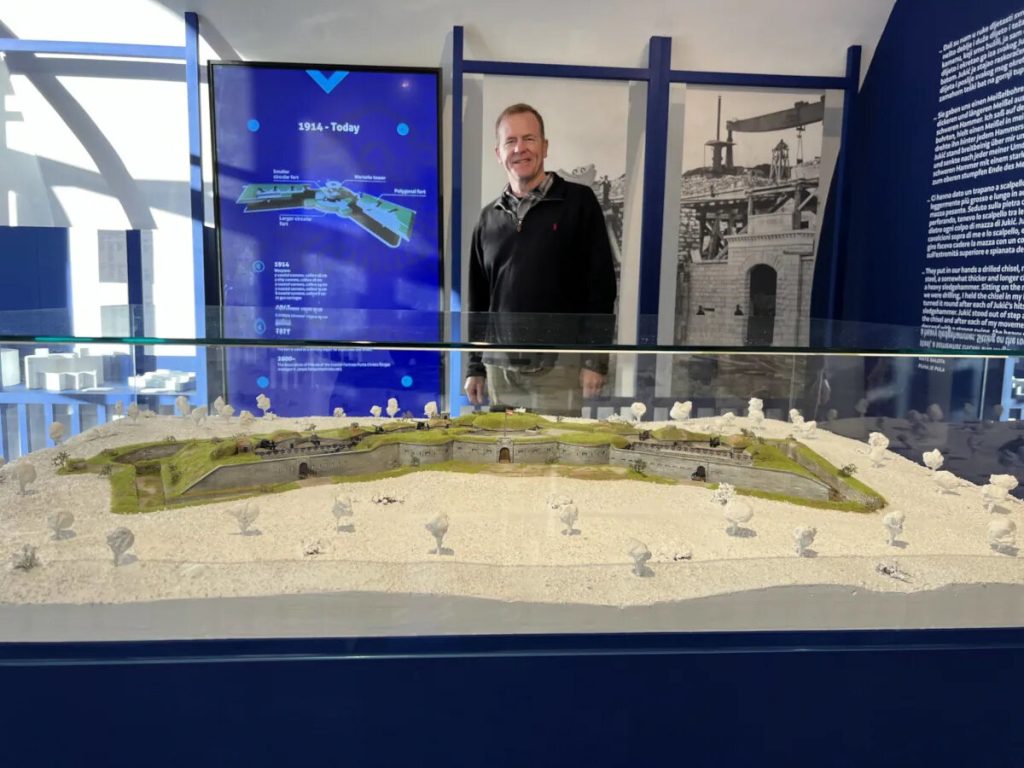


Pula from the top of the walls of the fort
In addition to the museum, we also enjoyed walking the walls of the fort to get an overview of the city and its shipyard, which has suffered from the same economic forces as the rest of Europe and North America. Shipbuilding in Croatia is only a shadow of its former glory under the Austro-Hungarian and even into the post-war years. Its cranes were once a symbol of industrial majesty but today are monuments to the rise of China and the shifting of the industrial epicenter to the Far East. The shipyard is not completely shutdown but it operates at a fraction of its historic capacity. The cranes make for good photography and in past years have even been lighted different colors under the marketing slogan of “Lighted Giants” in order to add value in the tourism sector to offset their slight contribution to the industrial sector.
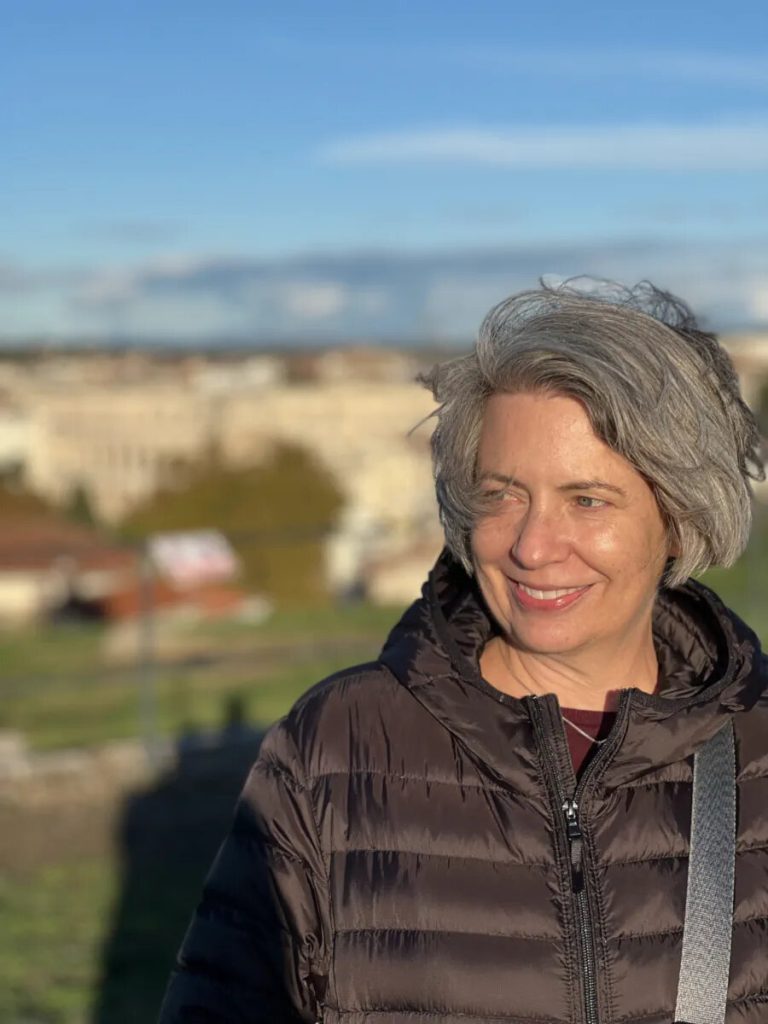

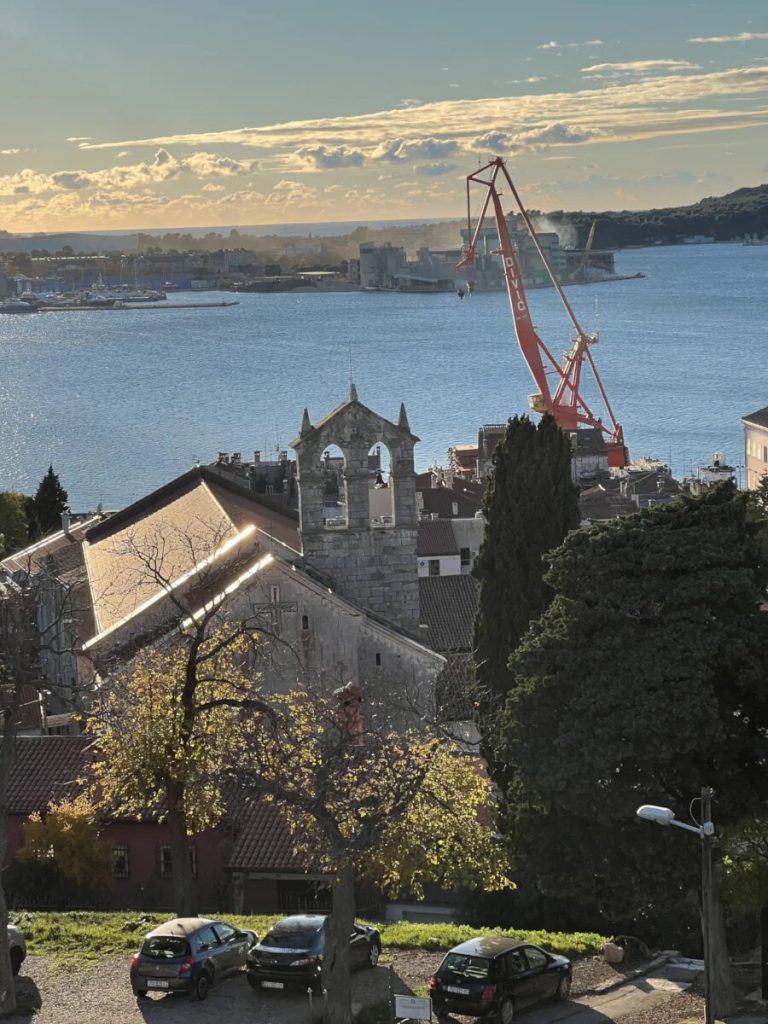
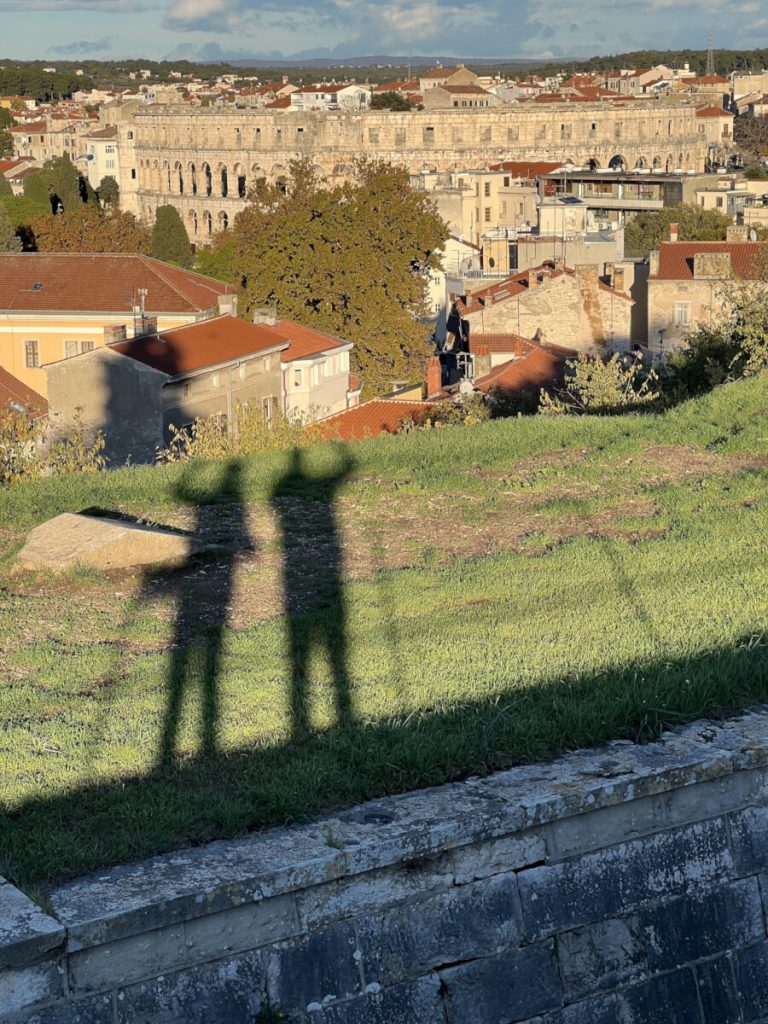



Strolling the streets of Pula
The amphitheater and fortress filled most of our day but we also walked streets of Pula and took in its Adriatic charm. On a map, the fortress sits at the center (and on top) of the hill and is ringed by concentric streets at descending altitudes with spokes running up the hill. The curving streets and straight hills make for good photography.
We also came across a scale model of the city in bronze casting which helped explain the walled fortifications better than Google Maps can. As we walked around the walls, you could see places where materials had clearly been taken from other structures (the amphitheater perhaps?). The builders weren’t shy about recycling materials. Pula also has several arches dating to the first century B.C. to the third century, including the Gate of Hercules, the Arch of Sergii, and the creatively named “Twin Gate”.
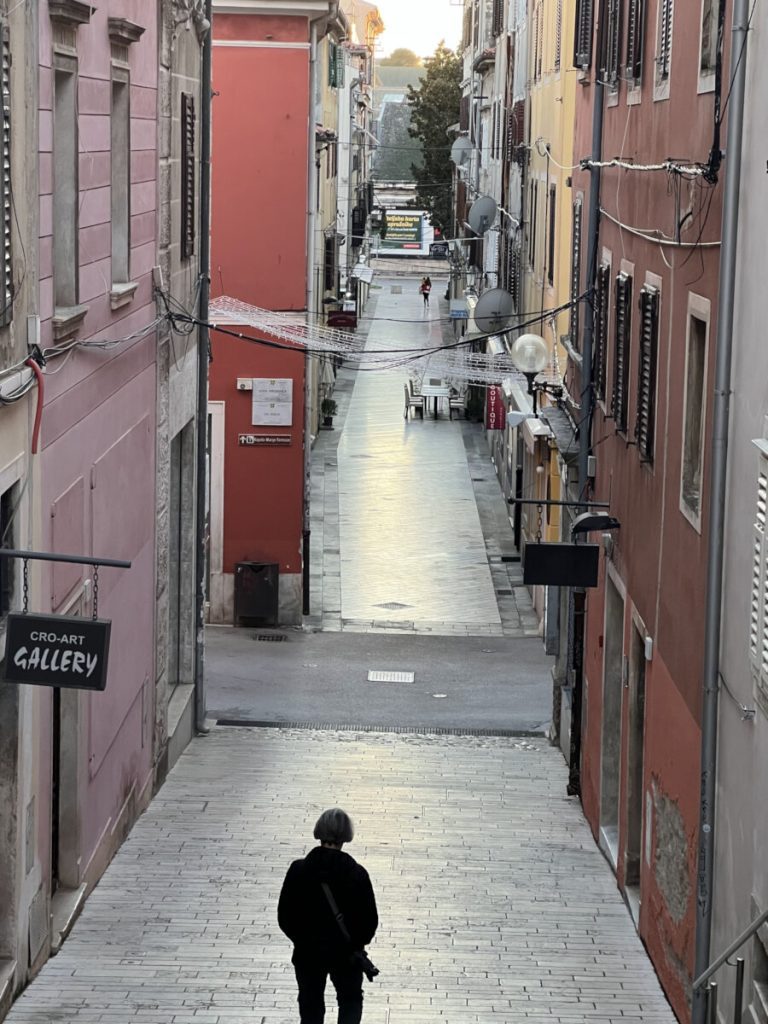




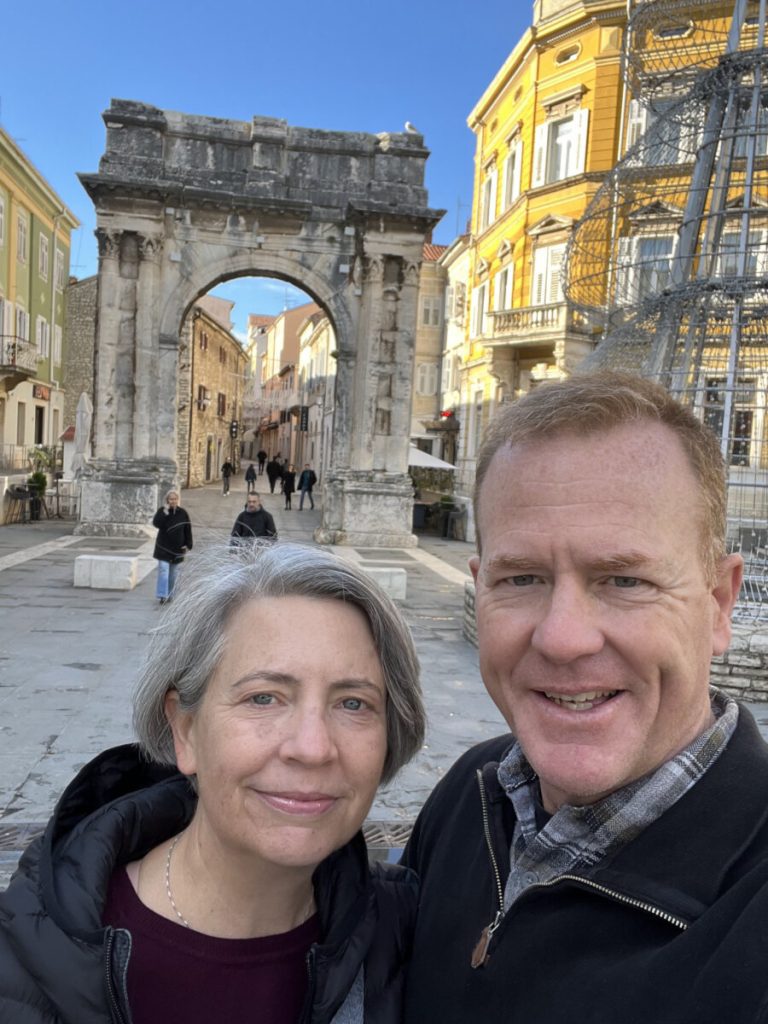



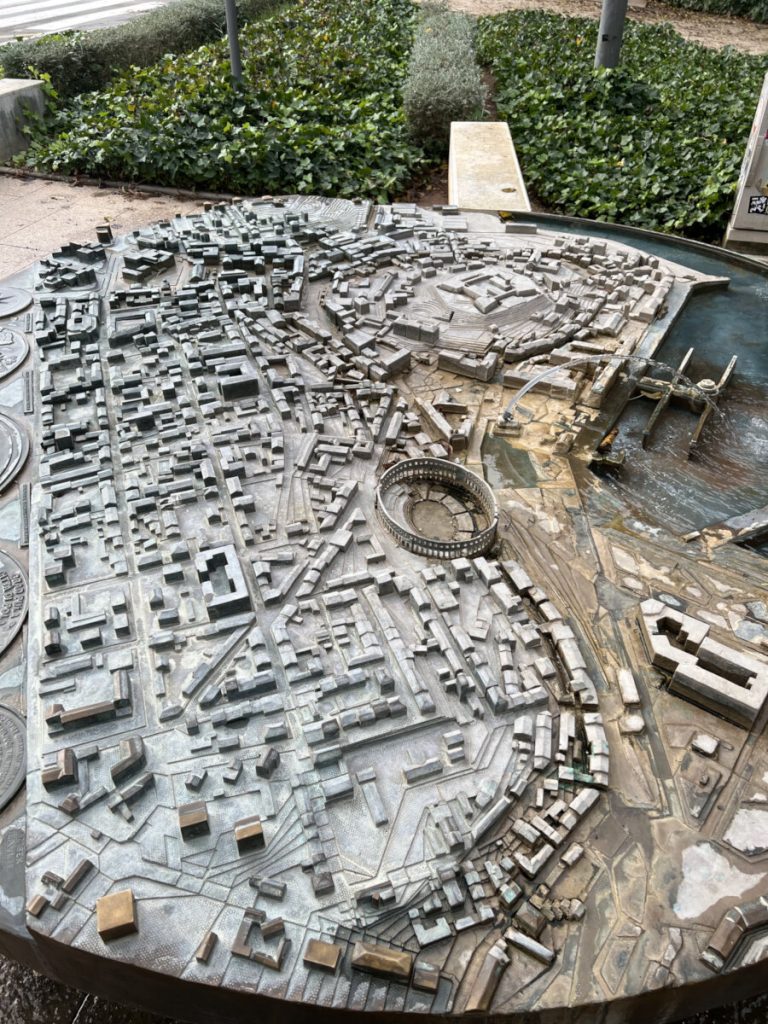
James Joyce Lived in Pula…Seriously
In the spirit of “George Washington slept here”, Pula takes credit for being one of the places James Joyce lived as a young man in 1904-05 when he was only 22 years old. He ended up in Pula because he was trying to get his book “Portrait of the Artist as a Young Man” published on the continent after it was rejected in Ireland for being critical of the Catholic Church and cultural norms in Ireland. So he left Ireland thinking he had a job lined up teaching English for the Berlitz language school in Zurich but when he got there, the job opening was gone. Berlitz sent him to Trieste, Italy and when he got there the same thing happened. From there, Berlitz sent him to Pula where he lived for only six months. Most of his students were officers from the Austro-Hungarian naval base. He wrote a rather unflattering letter about Pula to his aunt and eventually got transferred back to Trieste. Despite his uncharitable description of Pula, they have a nice sculpture of James Joyce at an outdoor café table near the Arch of Sergii, just a few feet from the building where he taught English.
James Joyce was only two years younger than Georg von Trapp and they very possibly could have met or at least had common acquaintances during their brief overlap in Pula. Georg von Trapp was then a junior officer in the Navy rising through the ranks; he initially served on surface ships, most of which were homeported in Pula, and didn’t volunteer for submarine duty until 1908.
While researching this sculpture, I came across a terrific article from 2013 on the website Literary Traveler called “James Joyce and the Golden Gate of Pula”. https://www.literarytraveler.com/articles/james-joyce-and-the-golden-gate-of-pula/
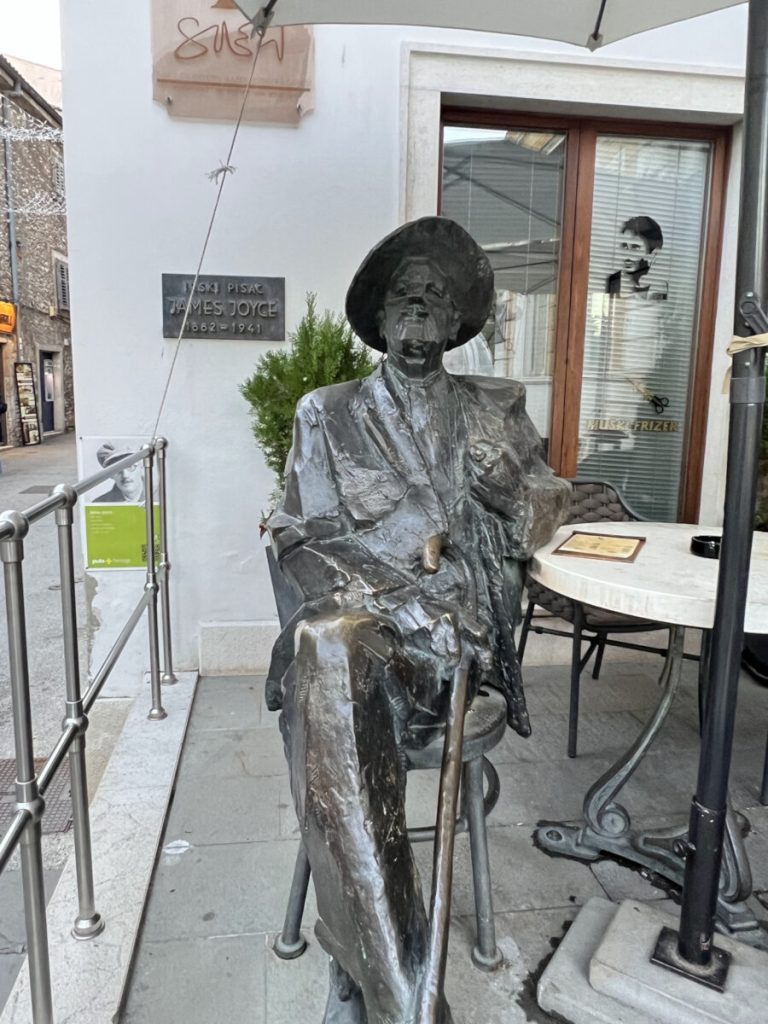
Popeye’s Girlfriend in Pula?
We visited the Istrian Olive Oil Museum in downtown Pula. The museum exhibits walk visitors through the history of olive oil production all the way back to Roman settlement and the evolution of techniques for large scale production and distribution across the Roman world. One major byproduct of olive oil production was the manufacture of clay “amorphae” pots used for transporting the olive oil. These were kind of like the shipping containers of the ancient world and the Romans produced these by the tens of thousands. Since many of them were marked with the name of the owner, these clay pots have become a staple of archaeological analysis to show the extent of trade routes and economic relationships.
The museum explained that in the contemporary olive oil market, Istria is too small to compete with the large scale producers (Greece, Italy, Spain, etc) who make the olive oil you find at Food Lion. Instead, Istria has embraced the artisan olive oil market, focusing on quality over quantity. The museum is a bit of a self-promotion by the olive growers of Istria so it unsurprisingly emphasized the health benefits of consuming olive oil and claims that Istrian olive oil has a higher concentration of the “phenolic compounds” that underpin olive oil’s health benefits. We also learned to think of olive oil as a fruit juice and that it loses quality if the olives are not processed within 48 hours of being picked from the trees.
At the end of the hour-long museum tour, we sampled some olive oil and were startled to discover that high quality olive oil burns your throat a bit when you swallow it and that it is SUPPOSED to do that as a sign of quality. No kidding. The high quality oil made both Lyn and me cough. It smelled great and had a wonderful grassy flavor, but it was harsh when it hit the back of the throat. By the end of the tasting, they have you convinced that buying olive oil in a supermarket is a fool’s errand. I tend to disagree but I definitely admire the passion of the lady who ran the tasting and instructed us on how “real” Extra Virgin Olive Oil should smell and tasted.
And if you remember nothing else about olive oil, remember that it’s a fruit juice and although it is shelf stable at room temperature for over a year, olive oil will degrade when exposed to heat, light, and time. Purists buy olive oil in the darkest tinted glass and NEVER take it from the top shelf because of exposure to the overhead light. Bottom shelf olive oil is okay. We also learned that “extra virgin” doesn’t guarantee you are getting the best possible olive oil, but if it doesn’t say “extra virgin” then you might as well not even buy it.






Istria at sunset
The winter season gave us some great sunsets during our week in Istria. In case you didn’t see enough photos of the amphitheater, we took a few more while playing with the fading light.
The laundry shot was just something that caught my eye on our walk home. When you look for an apartment on Air BnB, you learn that most places have washers but dryers are very uncommon. Not surprisingly, you see people’s laundry hanging all over the place. This was also true in Spain and Portugal. If you have a dryer in your house, you should be thankful for the luxury.
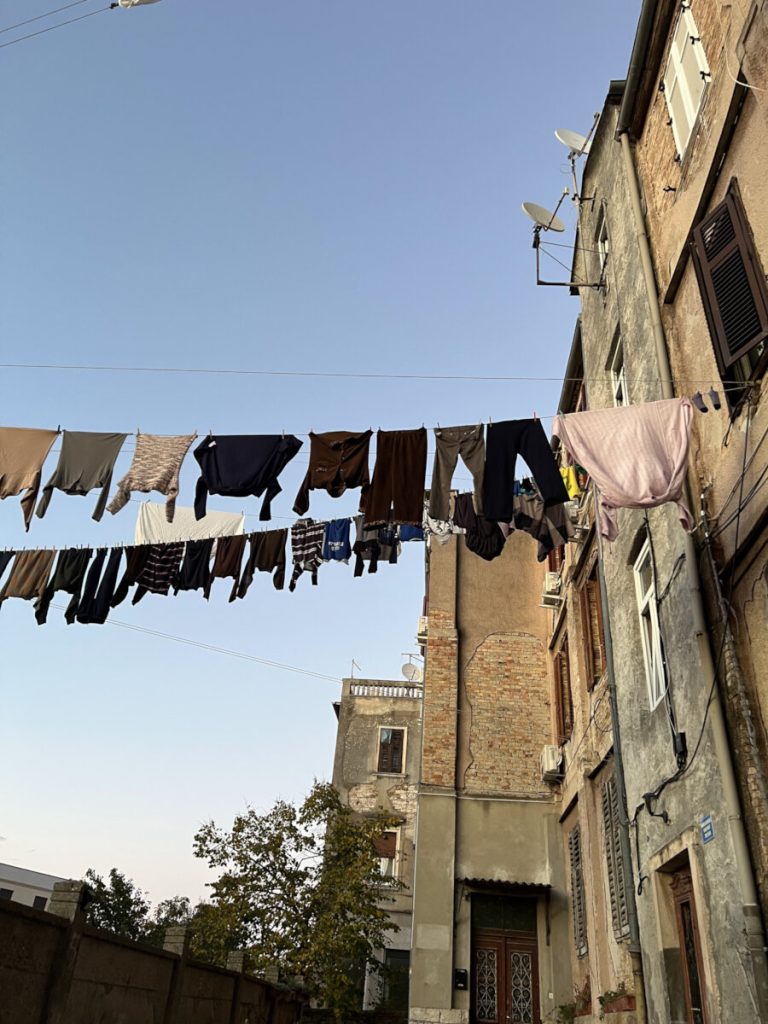

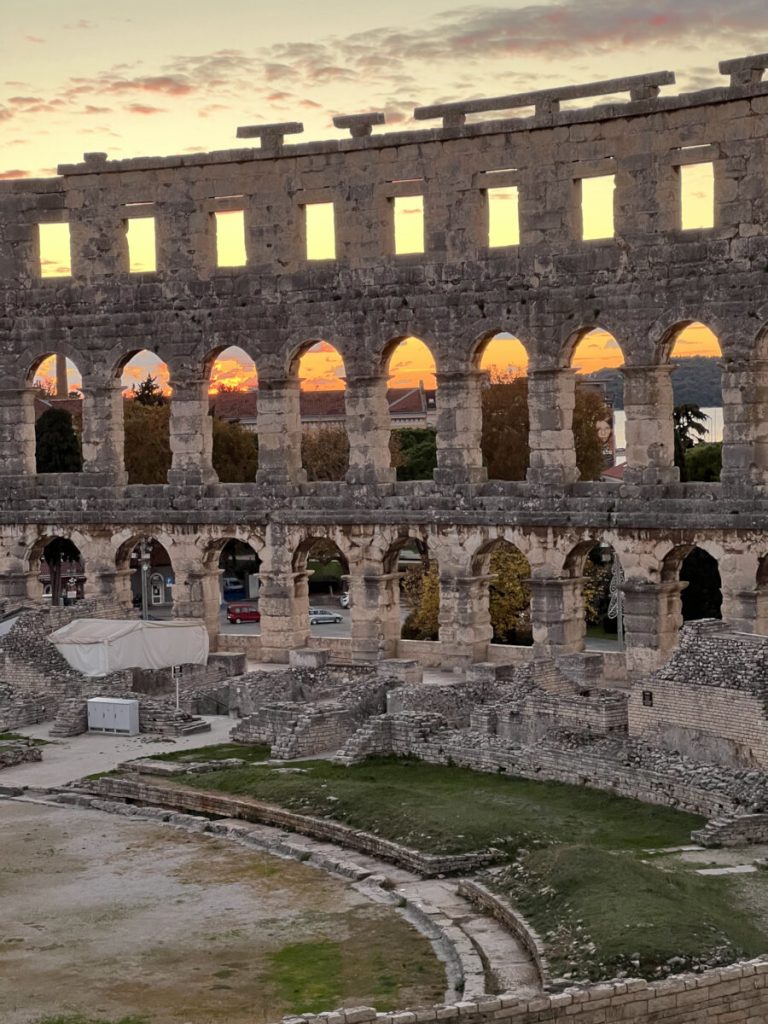



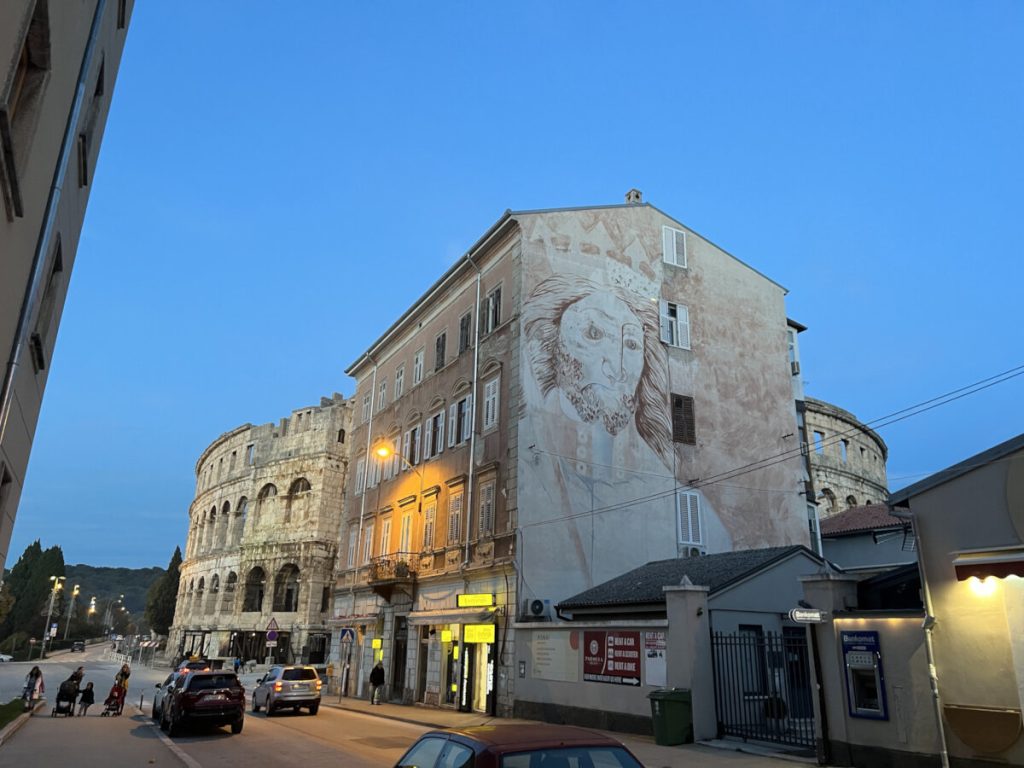
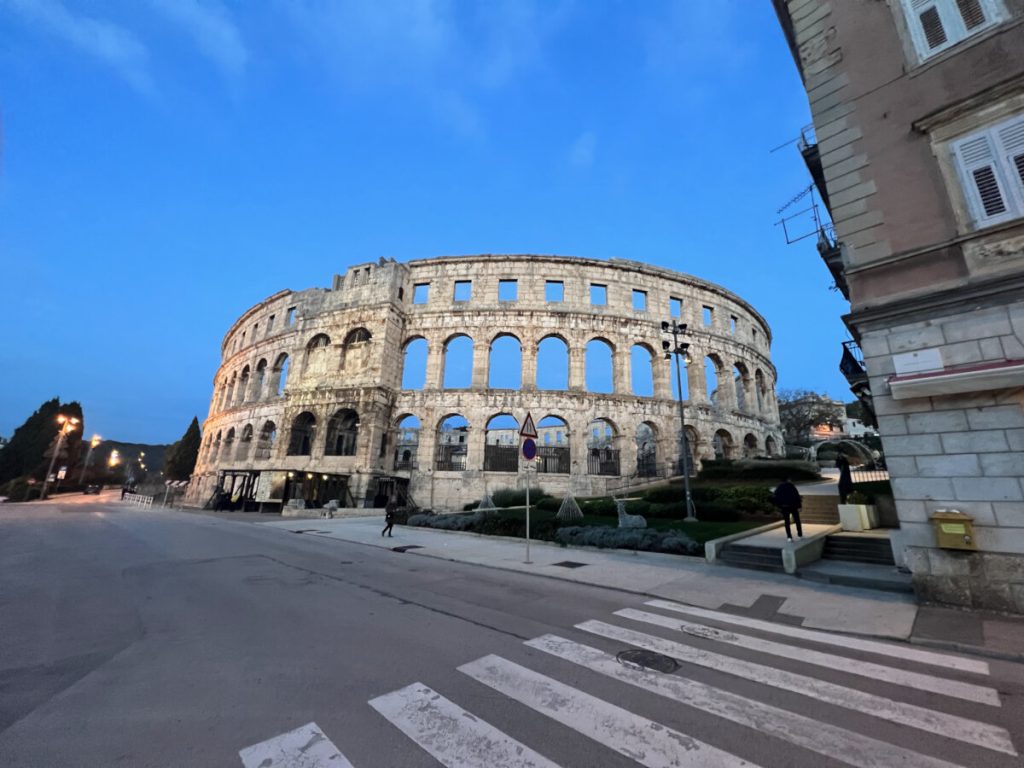
A week in Pula wasn’t enough
We spent a full week in Pula, but we lost one day to bad weather (good opportunity for catching up on the blog) and then we lost three days to road tripping across Istria for Thanksgiving weekend. We saw a lot of Pula, including some walking and shopping adventures not included in this post, but wished we could have stayed another few days after our road trip. During our visit, we saw the city workers and businesses decorating for the Christmas season. When we returned to town on the Saturday of Thanksgiving weekend, we were excited to find the city center lit up and local population out in force celebrating the spirit of Advent. This was our second taste of Christmas in Croatia and it reinforced our very positive perception of Pula. We’ll share the photos in a later post.



